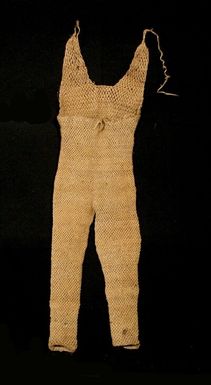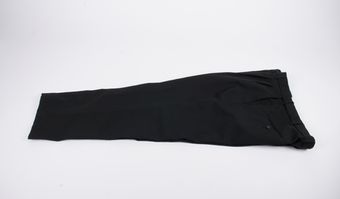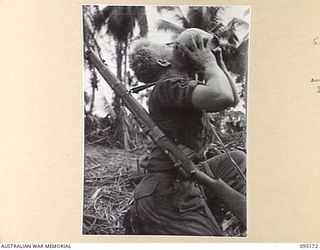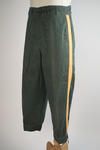Connect with National Museum of World Cultures Foundation
Contact this content partner to get more information about this item.
Long-sleeved costume with long trousers made of knotted coconut fibre
- Description:
- To protect themselves from shark teeth inlaid weapons, Kiribati warriors wore armour made from knotted coconut bark fibre. Sometimes human hair was incorporated into the knotwork. The equipment usually consisted of a jacket, trousers and a helmet (made of puffer or spiny fish) with ear protection. In addition, a high neck guard was worn, to protect against stones that the women threw at the enemy from behind. Sometimes the rock-hard dried skin of rays was wrapped around the belly for extra protection. The whole outfit was so heavy that in battle the warrior had a helper to carry his weapons for him. Because the equipment is so unusual for the region of Micronesia, it is believed that it was probably an outside influence.‖ The indigenous people of Kiribati were described in early European eyewitness accounts as particularly warlike. Family and clan groups fought each other constantly, and expeditions to other islands were organized. Warfare was highly ritualised and the two groups met at an agreed location in a fixed formation with the women, children, elderly and unarmed men looking on. They often supported their warriors by, for example, throwing stones at the enemy. The traditional warfare was not necessarily aimed at killing the enemy, so that conflicts could drag on for years if no compensation was paid. Hostilities were countered under British colonial rule and later by Christian missionaries. The weapons and defensive equipment for which this island group became so famous have therefore long since disappeared.
- Format:
- image
- Collections:
- National Museum of World Cultures Foundation
- Content partner:
- National Museum of World Cultures Foundation
- Availability:
- Not specified
-
Copyright status: All rights reservedFind out more about what you are able to do with this itemThis item is all rights reserved, with means you'll have to get permission from National Museum of World Cultures Foundation before using it. For more information, please see our use and reuse page.More informationNational Museum of World Cultures Foundation has this to say about the rights status of this item:
http://rightsstatements.org/vocab/InC/1.0/
What can I do with this item?Non-infringing useNZ copyright law does not prevent every use of a copyright work, and this item may be hosted by an international institute or organisation. You should consider what you can and cannot do with a copyright work.No sharingYou may not copy and/or share this item with others without further permission. This includes posting it on your blog, using it in a presentation, or any other public use.No modifyingYou are not allowed to adapt or remix this item into any other works.No commercial useYou may not use this item commercially.
Related items
Welcome and warm Pasifik greetings
The information on this site has been gathered from our content partners.
The names, terms, and labels that we present on the site may contain images or voices of deceased persons and may also reflect the bias, norms, and perspective of the period of time in which they were created. We accept that these may not be appropriate today.
If you have any concerns or questions about an item, please contact us.



